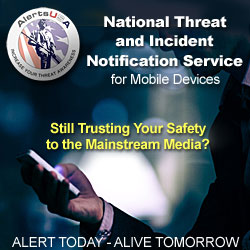I meant to write this article last year but time got away from me and then I misplaced my notes. My wife recently found my notes so I decided to write the article now. I had the opportunity to attend MSTEP, Minnesota Symposium on Terrorism and Emergency Preparedness, in November of 2011. This article will be about some of the things I learned about through MSTEP, but will not just be about Minnesota. I will discuss several of the threats that I believe we face from within our borders.
At the symposium there were four keynote speakers and twenty four classes to choose from. Each person attended eight classes they chose. Much of the information given was facts, and some of it overlapped between the various classes. Because of this, the article might be a list of facts and not flow all that well. I apologize.
There is not a nation on earth that could successfully invade America. Our armed forces are unparalleled, even if the majority of them are overseas. Also, as the Japanese General said, “You cannot invade the mainland United States. There would be a rifle behind every blade of grass.” For these reasons, I believe we will see small groups of people and even lone wolves that strike us. I wrote an article a couple years ago called Lone Wolves and Swarm Attacks that goes into more detail on them.
Gangs
There are an estimated 1,400,000 gang members in the Unites States. In this article from the military newspaper “Stars and Stripes”, the FBI says U.S. criminal gangs are using military to spread their reach. I have also read reports of gang members joining the military to learn tactics.
Unrestricted Warfare, China’s Plan to Destroy the USA
One of the keynote speakers mentioned that a Chinese Military manual touts different ways to attack America, which our Military could not deal with. Some of the attacks are terroristic in nature, while others are economic attacks.
Hackers Infiltrating our Infrastructure
I have linked various articles detailing hackers from unfriendly nations, such as Russia, China, and others in the Middle East, infiltrating our electric and water infrastructure. The thinking is that they are learning the systems and could shut them down at a later time.
Terrorist Attacks
From 9-11 until the fall of 2011, there have been 58 terrorist attacks stopped. Every two weeks there is another terrorist attack plotted. One of the keynote speakers said that a deputy director of the FBI said he believed a dirty bomb would go off in the USA. I have read other reports from people “in the know” who have predicted the same thing.
Somalis in Minnesota
You may have seen reports over the last few years of Somali men that immigrated to Minnesota, who were found dead in Somalia and other places in Africa. It was said that in 1991, charity organizations moved Somali refugees to Minnesota. On a side note, did these charities look at the weather differences between these two places? I digress, many of these families moved into the Twin Cities, which consists of Minneapolis and St. Paul. Most of the families continue their ethnic heritage and traditional dress and have not assimilated into American culture.
It is believed that these men were approached by Al Shibab, a Somali terrorist organization, in a Mosque in the Twin Cities. If they can recruit them to go back to Somalia and commit a suicide bombing, they can probably get them to do one in the states.
Pandemic
Trudee also attended a talk on the risk of pandemic and the response of healthcare in the Twin Cities and surrounding areas. Whether the pandemic is natural or “weaponized” this is an area of great enough concern that there are caches of antibiotics and others medications that might be needed. There are also several facilities that can be converted into mass dispensing facilities, and other facilities that will be used when local hospitals are filled.
Outside of Minnesota
I have seen multiple articles, such as this one from the Arizona Capital Times entitled Hezbollah terror threat on U.S.-Mexico border is real . The article is worth reading. It gives several examples of people tied to terrorist groups sneaking through our border with Mexico. One example is:
“According to Mr. Taylor, a Muslim cleric, Abdullah al-Nafsi, said that “there is no need for airplanes and planning; one man with the courage to carry a suitcase of anthrax through the tunnels from Mexico to the United States could kill 330,000 Americans in one hour.”
There are also issues at many of our ports. I read a report that said maybe only 10% of the cargo containers are checked. It would be quite easy for someone to sneak in along with some type of payload.
Please Don’t Dumb it Down
Terrorists have a thing for big elaborate attacks. 9-11 is well known, but there have been many other, mostly failed, attacks all over the world. Don’t get me wrong, they have some luck with collaborated attacks, sometimes bombing multiple US embassies in multiple countries.
When they have done the greatest damage is usually when one man acts alone, using easily attainable weapons. It is when they include multiple people or elaborate plots that they are arrested or fail.
Final Thoughts
There are so many potential threats already inside our borders, they only need to get lucky once for terror to set in, and liberty to slip away. Let’s pray for continued excellent law enforcement, as well as continued elaborate and failed plans for those who seek to do us harm.
If you liked this article please think about sharing it on the social media listed below, thanks!





